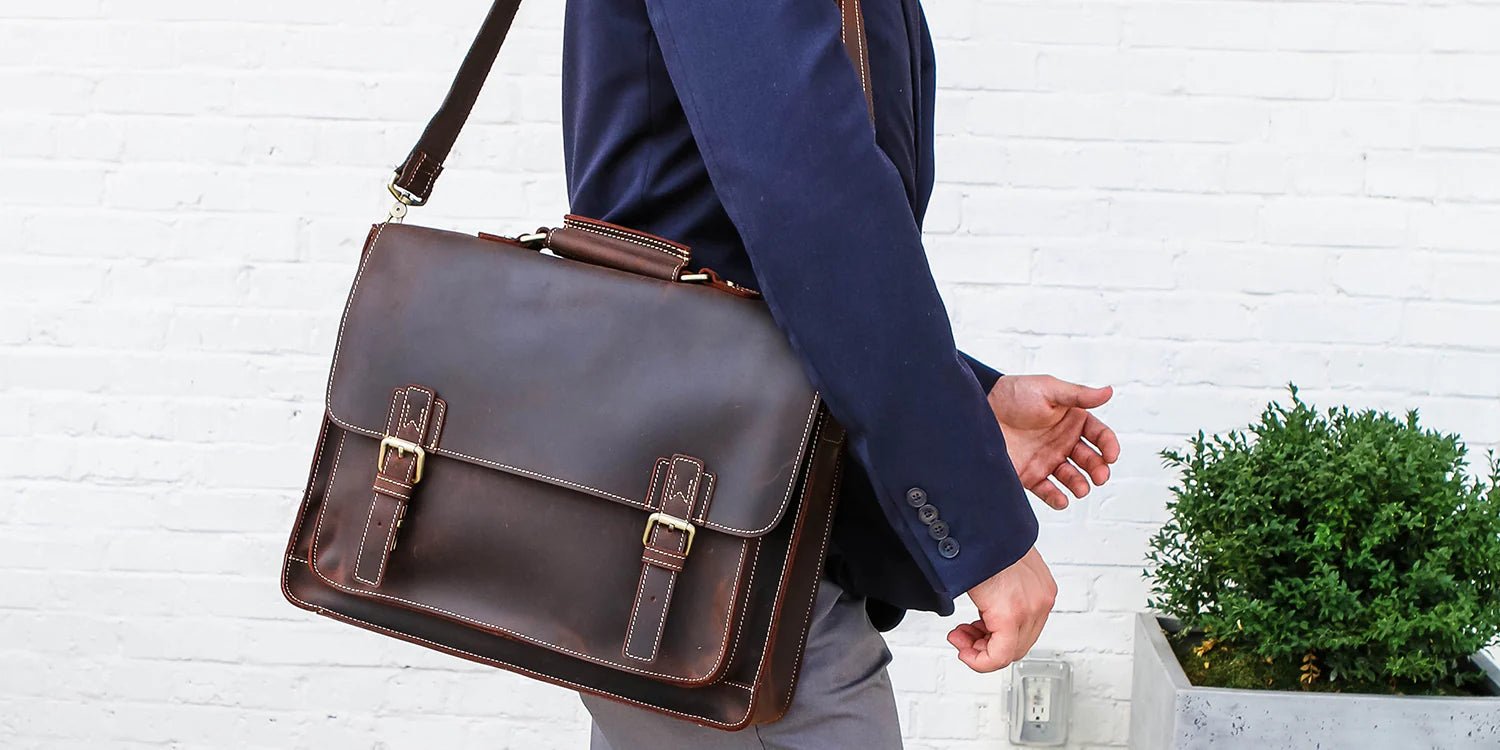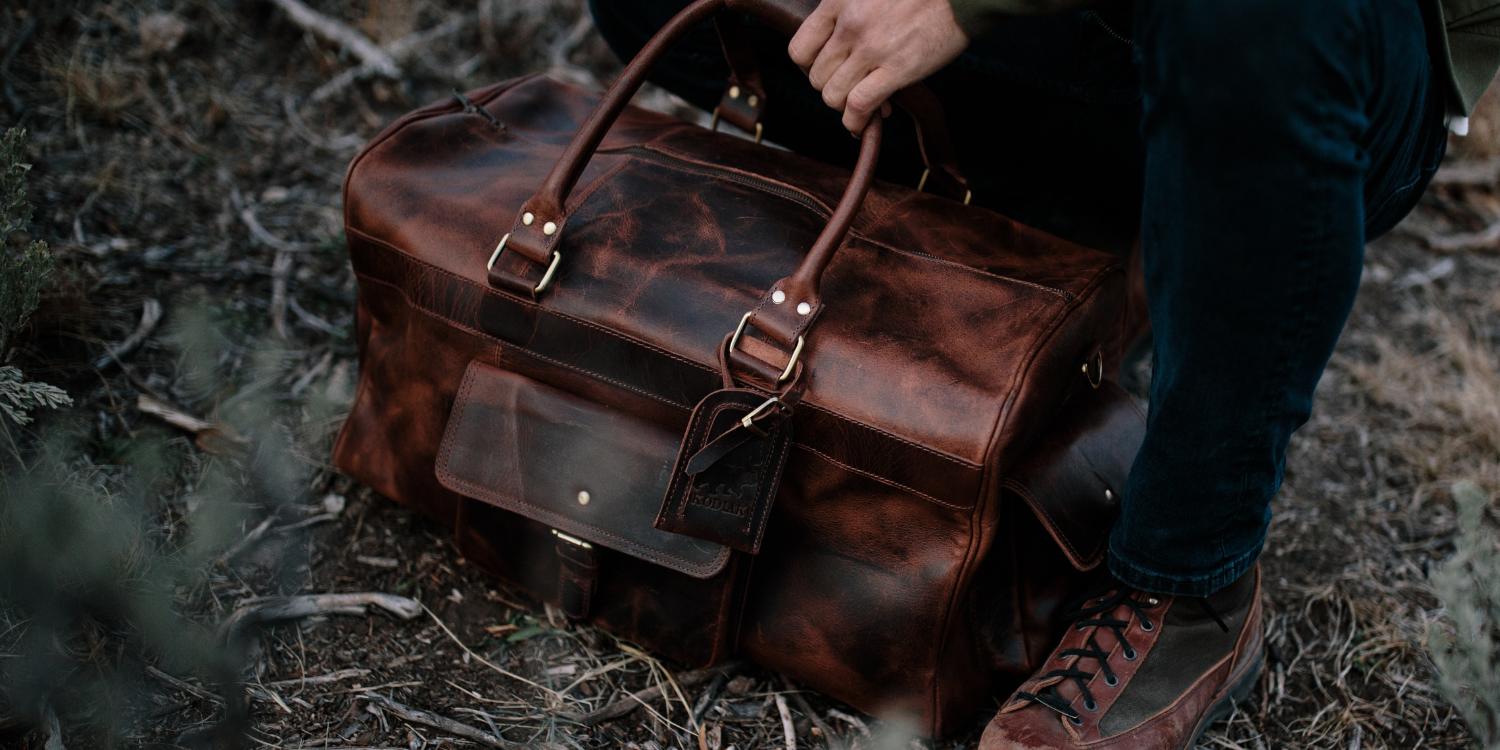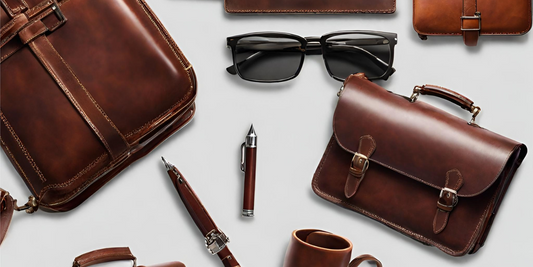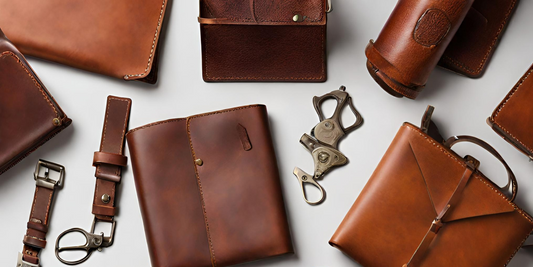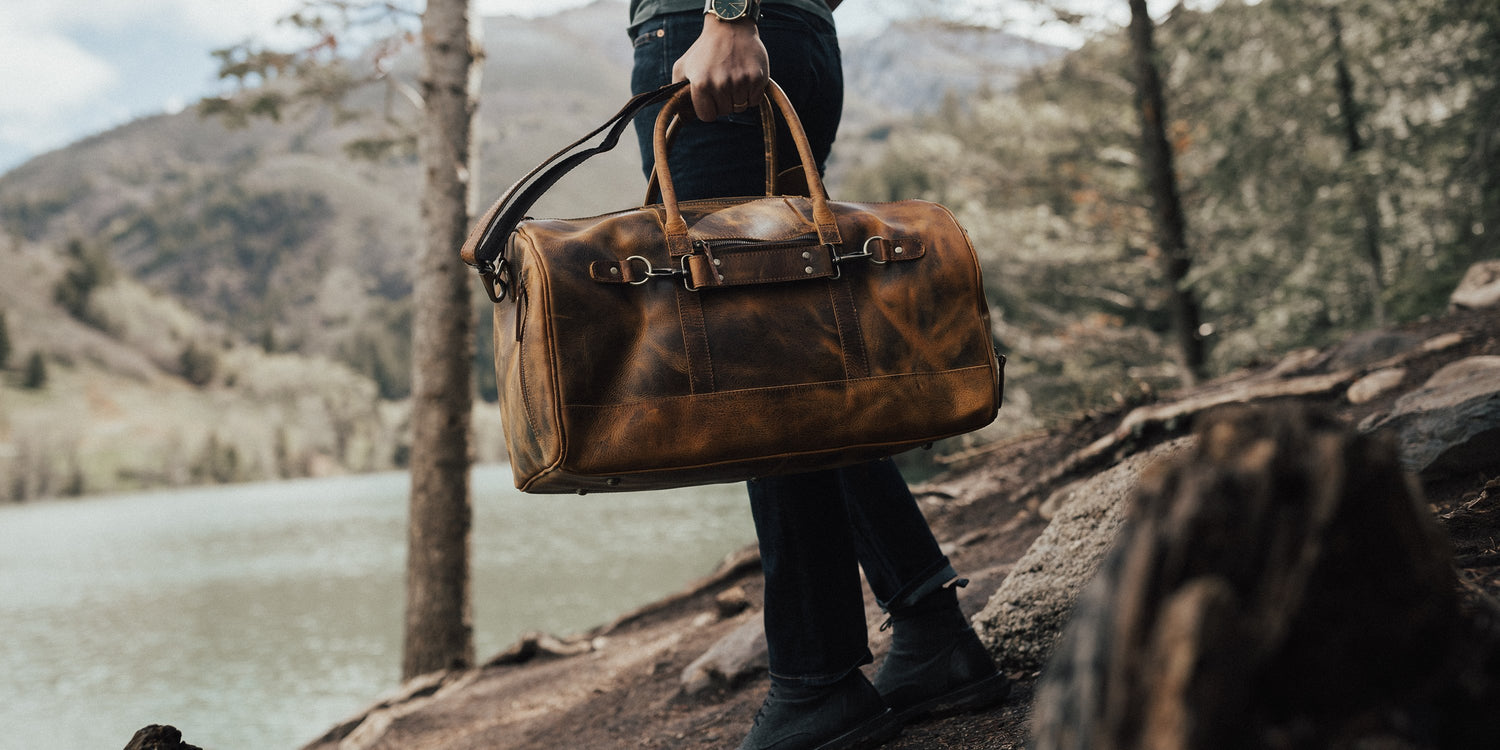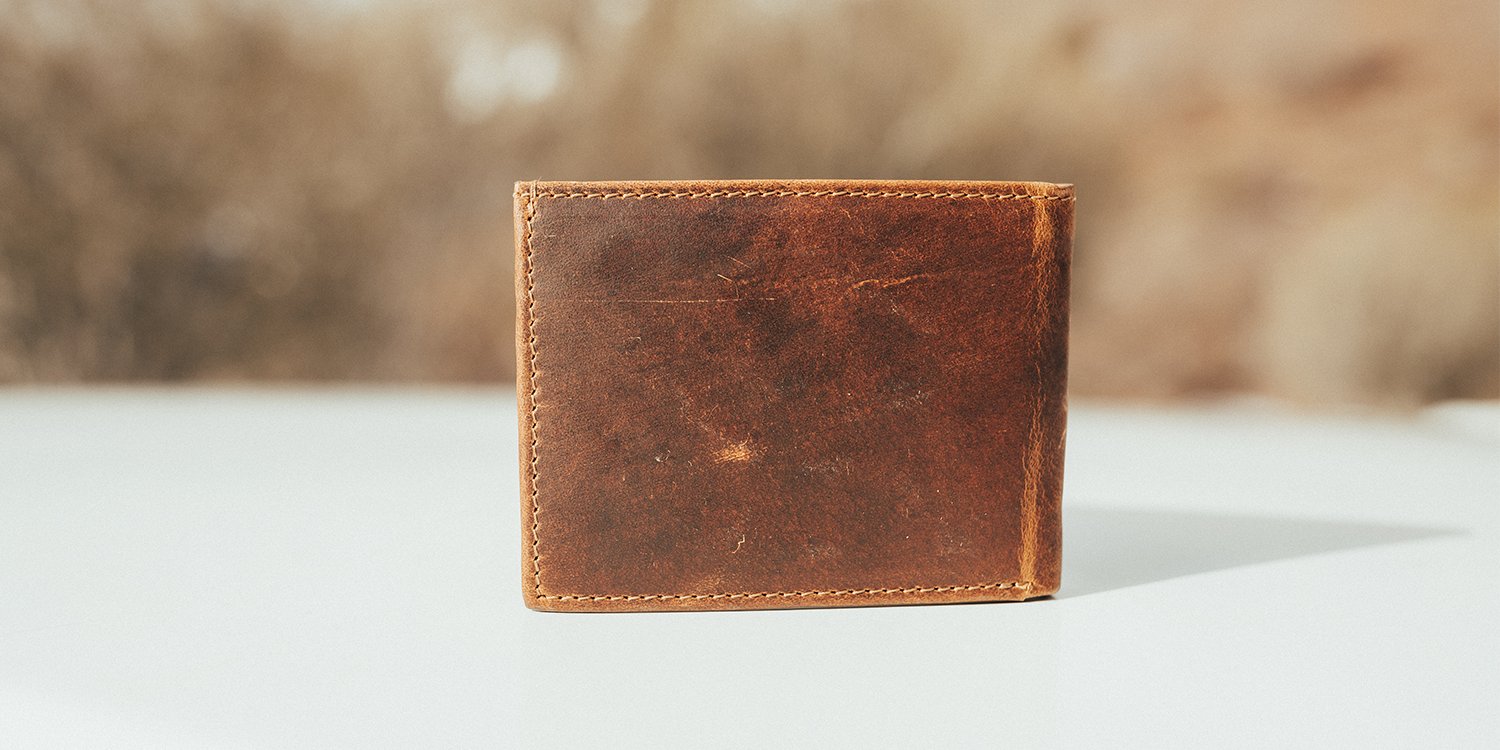It’s time to discover the tippity top of leather craftsmanship:
Top grain leather.
Renowned for its durability and luxurious feel, this premium material has captivated designers and aficionados alike.
Join us in this guide, as we unravel the secrets behind top grain leather's quality and versatility.
What is Top Grain Leather?
Top grain leather is a type of leather that comes from the most durable top layer of the animal hide.
Unlike full grain leather, which retains the entire grain layer, top grain leather undergoes a sanding process to remove imperfections, resulting in a more uniform appearance.
While this process may diminish some of the natural characteristics of the leather, such as texture and patina, it also creates a smoother surface that is more resistant to stains and scratches.
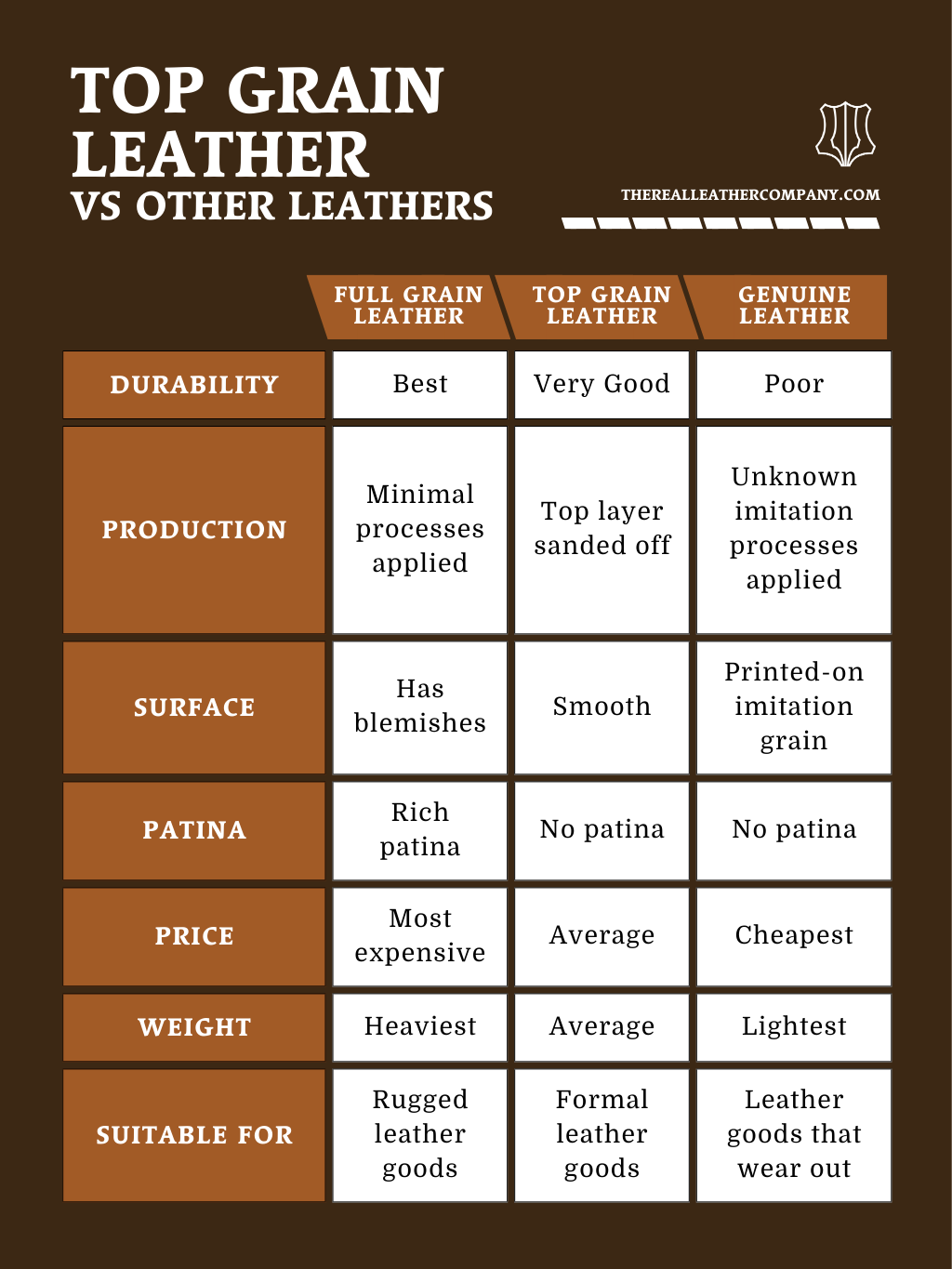
Should I Choose Top Grain Leather?
Top grain leather is a durable and smooth material that has a distinct appeal to many.
However, we appreciate that it may not be right choice for all customers.
In many cases, we recommend full grain leather instead.
Let’s take a closer look at the properties of top grain leather, its pros and cons and top grain vs other leathers.
Advantages of Top Grain Leather
1. Durability
Top grain leather is highly durable and resistant to wear and tear, making it ideal for products that require long-term use, such as leather bags and furniture.
2. Consistency
The sanding or buffing process used to create top grain leather results in a more uniform look, free of natural imperfections and blemishes.
This consistency enhances the aesthetic appeal of the leather. This ensures a sleek, professional appearance on the top surface of the leather.
3. Stain Resistance
The smoother surface of top grain leather makes it more resistant to stains, scrapes and spills compared to other types of leather.
This feature makes it easier to clean and maintain, prolonging the lifespan of leather products.
4. Affordability
While top grain leather is of high quality, it is generally more affordable than full grain leather.
This makes it a practical choice for consumers who value quality craftsmanship without the premium price tag.
5. Versatility
Top grain leather is versatile and can be used for a wide range of applications, from fashion accessories to upholstery.
Its adaptability makes it a popular choice among designers and manufacturers.

Disadvantages of Top Grain Leather
1. Less Natural Texture
The sanding or buffing process used to create top grain leather removes the natural texture and markings found in full grain leather.
As a result, top grain leather may lack the distinctive character and uniqueness of its full grain counterpart.
2. Reduced Breathability
The surface of top grain leather is smoother and less porous than full grain leather, which can affect its breathability.
This may result in a less comfortable experience, especially in hot or humid conditions.
3. Susceptibility to Stretching
While top grain leather is durable, it may be more prone to stretching and creasing over time compared to full grain leather.
This can affect the structural integrity and appearance of leather products, particularly those subjected to heavy use.
4. Patina
Unlike full grain leather, which develops a rich patina over time with proper care and use, top grain leather may have a more limited aging process.
This means that the leather may not develop the same depth of character and beauty associated with full grain leather.
5. Manufacturing Processes
The production of top grain leather often involves additional processes, such as sanding or buffing, which can contribute to environmental concerns and may involve the use of chemicals or dyes.
Consumers concerned about sustainability and eco-friendliness may prefer alternatives such as or vegetable-tanned full grain leather.

Top Grain Leather vs. Full Grain Leather
Both top grain leather and full-grain leather make excellent materials for the highest quality products.
As both leathers use the outermost layer of the hide, this gives both the strength and stability that can mean they last for decades with the proper care.
The main difference is that top grain leather will have had a sanding process done to it to hide any imperfections.
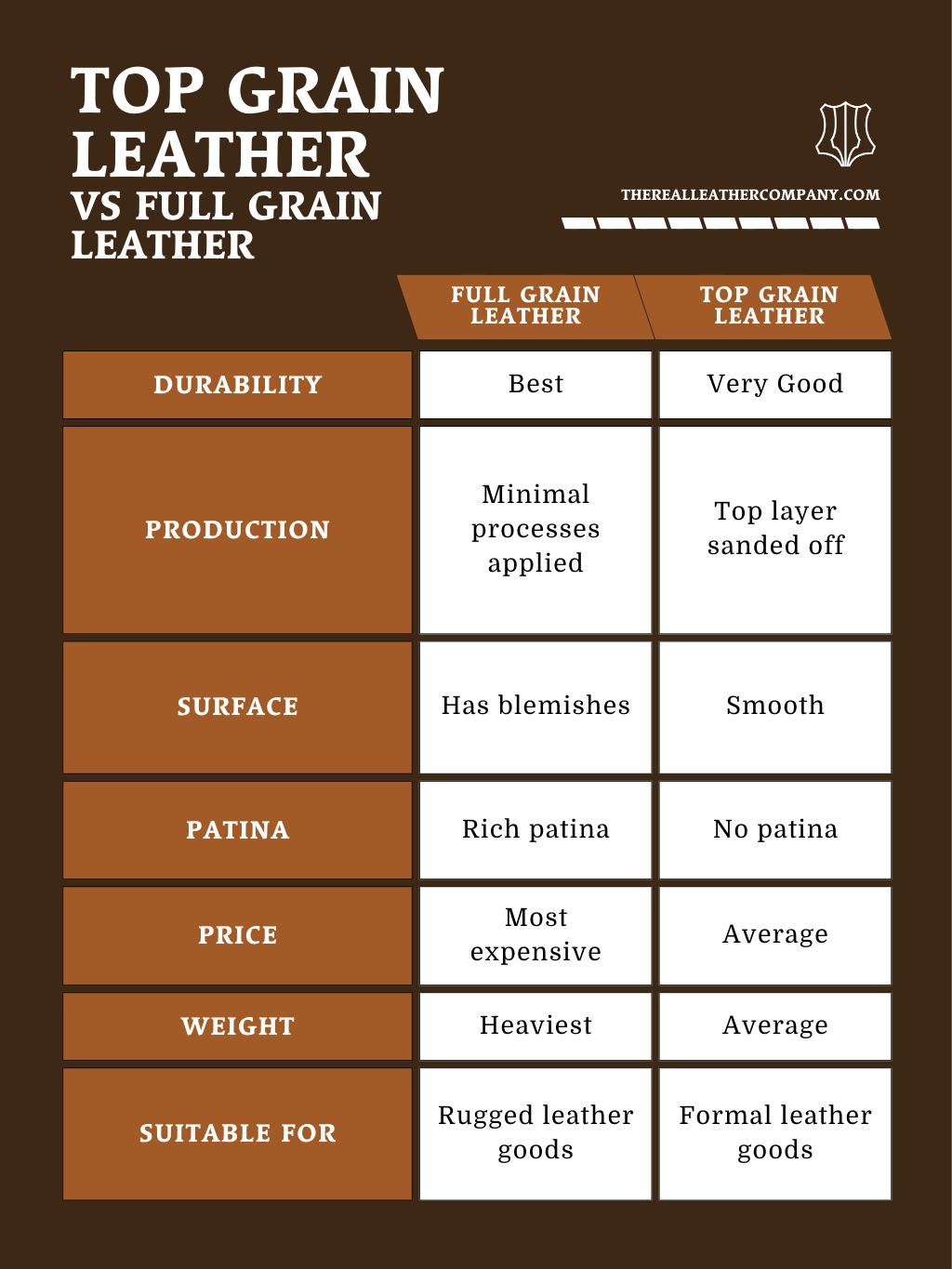
This gives a more polished finish by removing the grain pattern, but in terms of durability, makes full grain leather the highest quality of leather.
Because of this more polished finish, it is a very commonly used high-quality leather goods.
You can buy many luxury leather travel bags, backpacks and duffle bags that still maintain the classic leather qualities but also look really stylish.
Sometimes you will find that top-grain leather can be slightly shinier than full-grain leather.
This is down to treatments and tanning of the raw material.
It’s not always the case, but many find that this slightly smoother finish makes their leather bags easier to care for.
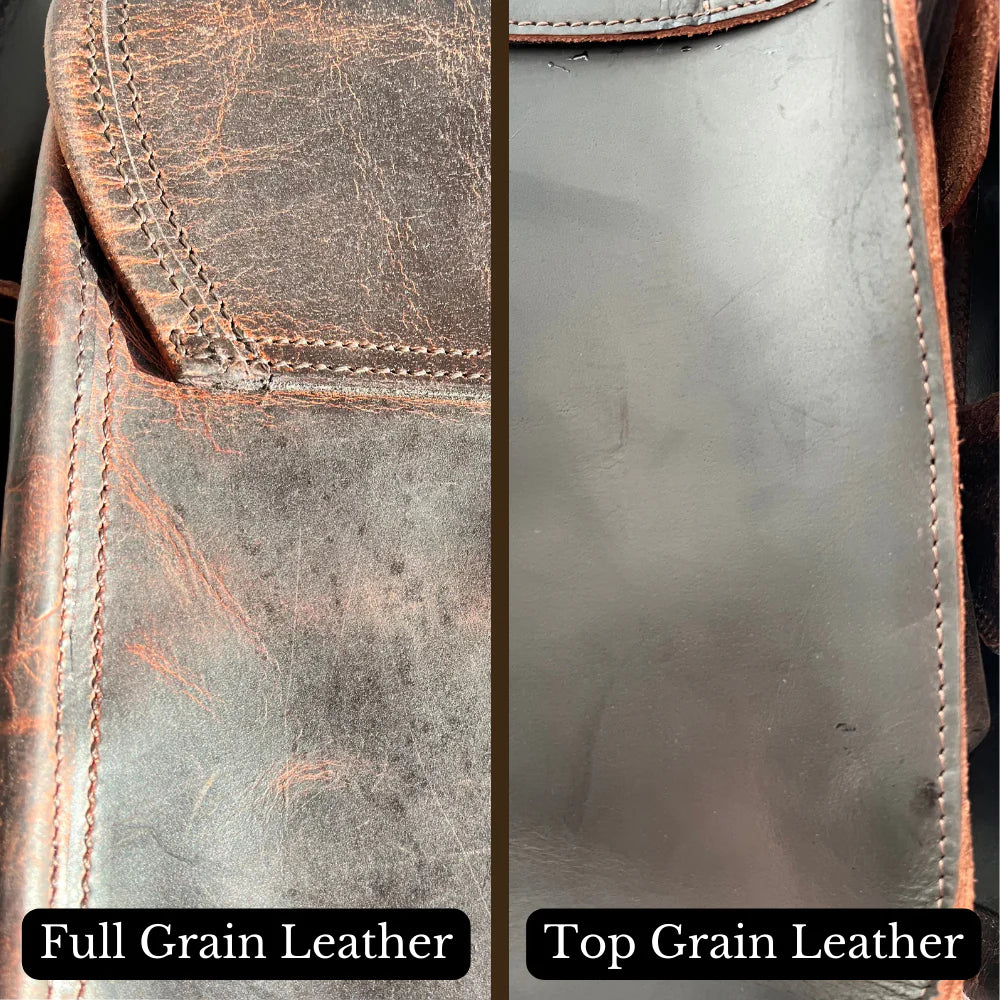
Top Grain Leather vs. Genuine Leather
Genuine leather is usually a term that describes lower quality leather.
Sometimes when you’re shopping for leather bags or goods, this can be a confusing term.
Genuine leather is not the same as top grain leather.
For an item to be marked as genuine leather, it just needs to contain some percentage of real leather.
This could be 100%, or it could 1% - you just don’t know and it’s very difficult to get access to the manufacturers that do know.
Genuine leather is often used to describe the lower layer of the cowhide (which is technically still real leather).
Still, it does not have the same durability or strength as the upper layer.
It means that a product that is real, genuine leather often doesn’t necessarily reflect the actual quality of the product.
It sounds like it’s the very best but that’s not always the case.
Corrected grain leather is also often categorized as genuine leather.
In reality, corrected grain or split leather is just top grain leather that has undergone additional processing to alter its surface further.
Examples mights be embossing, pigmentation or further sanding to completely remove the natural texture.
At The Real Leather Company, we guarantee quality leather bags and wallets made from only the top layer of the hide.
So you can be sure that what you’re buying isn’t just “technically leather”, it’s the real deal.
Interested in different types of leather? Check out our guides to suede, nubuck, aniline and bonded leathers.
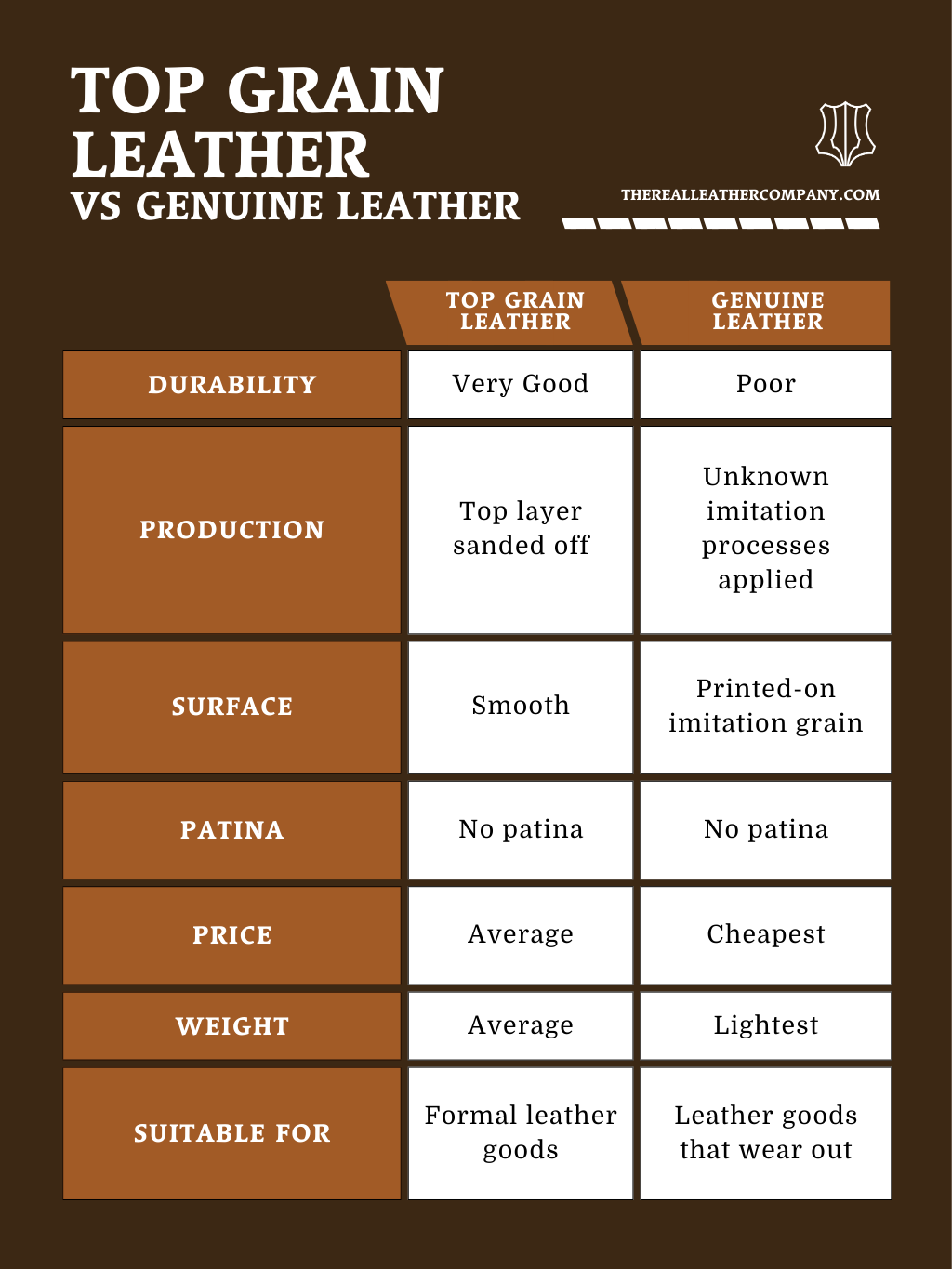
Top Grain Leather vs. Bonded Leather
Bonded leather is composed of leather scraps and waste pieces of leather leftover from the manufacturing process, which are bonded together with adhesives and coated with a polyurethane or vinyl layer.
While it may resemble top grain leather, bonded leather lacks any of the durability and longevity of top grain leather.
It is often used as a more affordable alternative but will degrade fast with use.
In our opinion, bonded leather is never a decent option for quality leather goods.
Common Uses of Top Grain Leather
The versatility, durability, and aesthetic appeal of top grain leather make it a preferred choice for a wide range of applications
1. Leather Bags and Accessories
One of the most popular uses of top grain leather is in the production of high-end leather bags, handbags, wallets, belts, and other fashion accessories.
Its durability, smooth texture, and ability to resist stains make it an ideal choice for everyday use items that require both style and functionality.
2. Upholstery
Top grain leather is frequently used in the upholstery industry to cover furniture such as sofas, chairs, and ottomans.
Its consistent surface and resistance to wear make it a practical choice for leather furniture in high-traffic areas.
3. Footwear
Many footwear brands utilize top grain leather in the construction of shoes, boots, and sandals.
The leather's durability and flexibility make it well-suited for footwear, providing comfort and long-lasting performance.
4. Automotive Interiors
Luxury car manufacturers often use top grain leather to upholster seats, steering wheels, and interior trim components.
Its premium appearance and resistance to fading and staining enhance the overall aesthetic and value of the vehicle.
5. Other Leather Goods
Top grain leather is also used to create a variety of leather goods beyond bags and accessories, including phone cases, watch straps, portfolios, and luggage.
Its versatility and ability to be crafted into different shapes and sizes make it a popular choice among artisans and designers.
6. Corporate Gifts and Promotional Items
Top grain leather products are often chosen as corporate gifts or promotional items due to their perceived value and durability.
Items such as branded leather notebooks, cardholders, and keychains can be customized with company logos or messages for a personalized touch.
7. Equestrian Equipment
Top grain leather is commonly used in the manufacturing of horse tack and riding equipment, such as saddles, bridles, and reins.
Its strength and suppleness make it well-suited for the demanding conditions of equestrian sports.
8. Interior Design
Designers and decorators frequently incorporate top grain leather into interior design schemes as accents or focal points.
Leather upholstery, wall coverings, and decorative panels can add warmth, texture, and sophistication to residential and commercial spaces alike.

How to Identify Top Grain Leather
Here are 3 telltale signs that the leather you’re looking at is top grain leather.
1. Smooth Surface
Look for a smooth and uniform surface texture.
Top grain leather typically has a consistent appearance without visible blemishes or imperfections.
2. Flexibility and Suppleness
Top grain leather is flexible and supple to the touch.
It should feel soft and pliable, with a slight give when pressed.
3. Slight Sheen
Top grain leather often has a subtle sheen or luster due to the finishing processes applied during production.
This sheen can vary depending on the type of finish used, but it is generally present to some degree.

How is Top Grain Leather Made?
Top grain leather is high quality material, that requires much experience to manufacture.
Here is the process that a tannery will follow.
1. Selection of Hide
The first step of the tanning process is to select the hide to use. This is crucial as it’s the biggest determinant on the quality of the leather on the backend.
Top grain leather is produced from the top, outer layer of the animal hide, known as the grain layer.
This layer is selected for its smooth texture and consistent quality, making it ideal for leather production.
2. Splitting
The tannery then splits the animal hide into layers, with the top layer retained for top grain leather production.
This layer is thinner and more flexible than the lower layers, which are often used to create split grain or suede leather.
3. Sanding or Buffing
Once the top layer is selected, it undergoes a process of sanding or buffing at the tannery to remove imperfections and blemishes from the surface.
This process smooths out the leather and creates a more uniform appearance, enhancing its aesthetic appeal.
When creating full grain leather, this step would be skipped.
4. Finishing
After sanding or buffing, the top grain leather may undergo additional finishing processes to enhance its durability, color, and texture.
These processes can include dyeing, embossing, or applying protective coatings to the surface.
5. Quality Control
Throughout the manufacturing process, top grain leather is subjected to rigorous quality control measures by the tannery to ensure consistency and adherence to industry standards.
Inspections may be conducted at various stages to identify any defects or irregularities that need to be addressed.
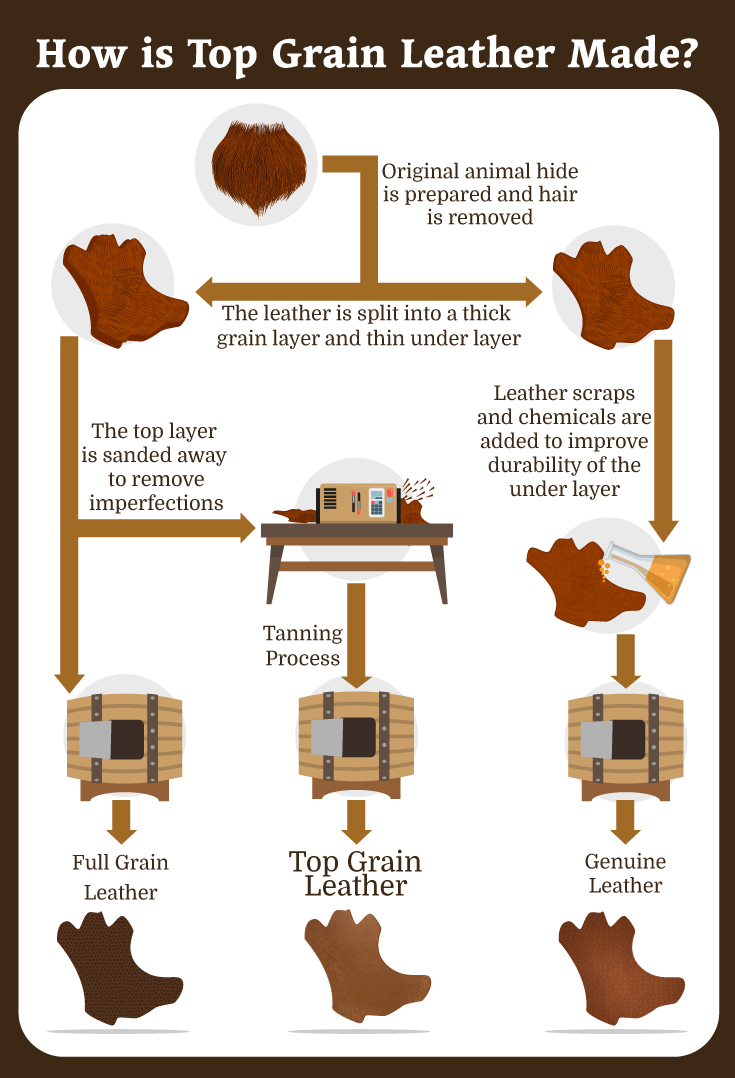
How to Care for Top Grain Leather
By following these simple care tips, you can prolong the life and beauty of your top grain leather items, ensuring they remain looking their best for years to come.
1. Regular Cleaning
To keep top grain leather looking its best, regularly remove dust and dirt using a soft, damp cloth.
Gently wipe the surface in a circular motion to avoid scratching or damaging the leather.
2. Avoid Excessive Moisture
While top grain leather is more resistant to stains than other types of leather, it's still important to avoid exposing it to excessive moisture.
If the leather gets wet, gently pat it dry with a clean cloth and allow it to air dry naturally.
Avoid using heat sources such as hairdryers, as they can cause the leather to crack or become stiff.
3. Use Leather Conditioner
Periodically treat top grain leather with a high-quality leather conditioner to keep it moisturized and supple.
Apply the conditioner using a clean cloth, rubbing it into the leather in a circular motion.
Allow the conditioner to penetrate the leather for a few minutes, then buff off any excess with a dry cloth.
4. Protect from Sunlight
Direct sunlight can cause top grain leather to fade and dry out over time.
To prevent this, avoid placing leather items in direct sunlight for prolonged periods.
If possible, use curtains or blinds to block out harsh sunlight, especially during peak hours.
5. Store Properly
When not in use, store top grain leather items in a cool, dry place away from direct heat sources and sunlight.
Use dust covers or breathable fabric bags to protect leather bags and accessories from dust and scratches.
6. Handle with Care
Treat top grain leather items with care to avoid scratching or scuffing the surface.
Be mindful of sharp objects and rough surfaces that could damage the leather.
When carrying leather bags, avoid overloading them to prevent stretching or distortion of the leather.
7. Spot Cleaning
In the event of spills or stains, gently blot the affected area with a clean, dry cloth to absorb excess liquid.
Avoid rubbing or scrubbing, as this can spread the stain and damage the leather. For stubborn stains, consult a professional leather cleaner for guidance.

Does Top Grain Leather Make Good Products?
Absolutely!
As one of the highest grades of leather (behind only full-grain leather), top grain leather makes excellent, long-lasting products.
It is most commonly used for bags, briefcases and travel bags because of its higher quality and durable nature.
A top grain leather backpack, for instance, would be an excellent choice for a regular traveler or someone looking for a long-term solution for everyday use.
High-quality leathers are incredibly tough and fairly water-resistant (although they should be allowed to dry naturally if they do get wet).
So they make an excellent choice for heavy-wear products.
Top grain leather briefcases are an extremely popular gift.
Maybe you’re buying a present to celebrate a milestone achievement like a promotion or a birthday.
Our customers regularly share stories of their loved ones receiving their real leather gifts and it shows how much these high-quality investment pieces are valued.
FAQs
1. What is the difference between top grain leather and full grain leather?
Top grain leather comes from the top layer of the hide. It is sanded or buffed to remove imperfections, resulting in a smooth surface.
Full grain leather retains the entire grain layer, including natural markings and texture, making it more rugged and authentic in appearance.
2. Is top grain leather durable?
Yes, top grain leather is known for its durability and resistance to wear and tear.
Its smooth surface and consistent quality make it an ideal choice for products that require long-term use, such as bags, furniture, and accessories.
Top grain leather will be less durable than full grain leather because the natural grain has been sanded away.
But, top grain leather is always more durable than lower grade leather such as genuine leather or bonded leather. And always more durable than faux leathers.
3. How do I clean and maintain top grain leather?
Regularly clean top grain leather with a soft, damp cloth to remove dust and dirt.
Avoid excessive moisture and direct sunlight, and periodically treat the leather with a high-quality leather conditioner to keep it moisturized and supple.
4. Is top grain leather waterproof?
While top grain leather is more resistant to stains and spills than other types of leather, it is not completely waterproof.
It can withstand minor exposure to moisture, but prolonged or excessive contact with water can cause damage and discoloration.
5. Does top grain leather develop a patina?
Top grain leather is unlikely to develop a patina as the very top layer of the animal hide has been sanded away during the production process.
6. Is top grain leather more affordable than full grain leather?
Yes, top grain leather is generally more affordable than full grain leather.
The sanding or buffing process used to create top grain leather makes it easier to work with and produces a more consistent appearance, resulting in a lower cost compared to full grain leather.
7. Can I repair scratches and scuffs on top grain leather?
Minor scratches and scuffs on top grain leather can often be buffed out or treated with a leather conditioner to minimize their appearance.
For deeper scratches or damage, consult a professional leather repair specialist for guidance and assistance.
8. What are the common uses of top grain leather?
Top grain leather is used for a wide range of applications, including bags, accessories, upholstery, footwear, automotive interiors, equestrian equipment, and interior design accents.
Its versatility and durability make it a popular choice across various industries.
